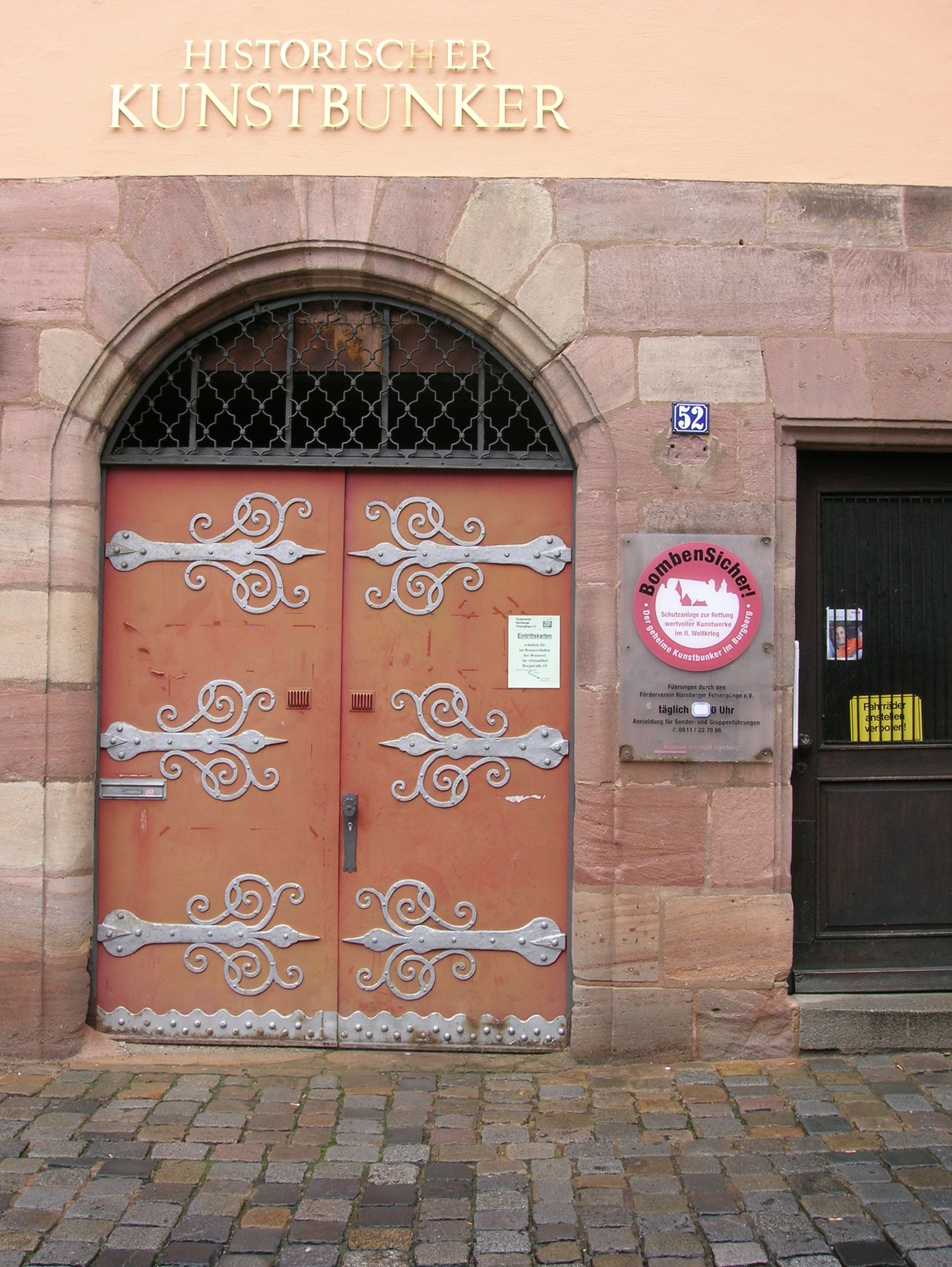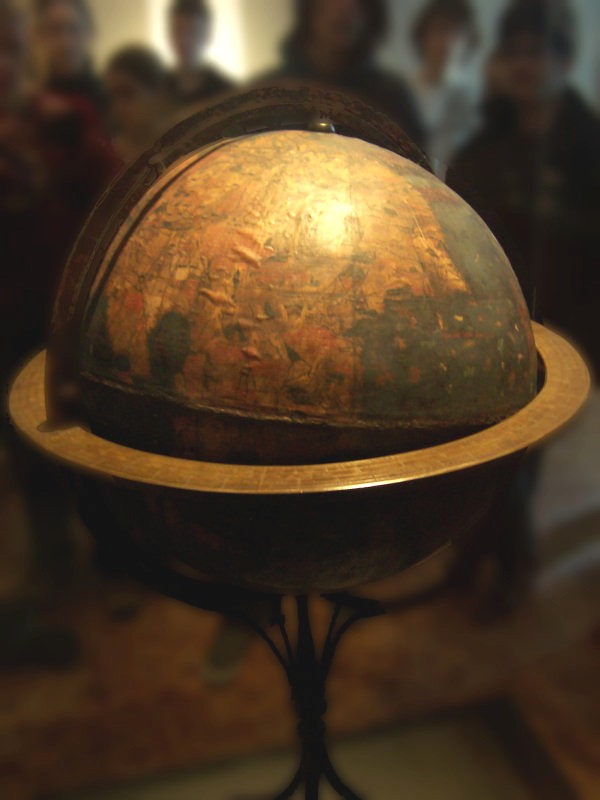|
Historischer Kunstbunker
The Historische Kunstbunker (Historic art bunker) is a tunnel complex under Nuremberg Castle in the old city of Nuremberg, southern Germany. It forms part of the Nuremberg Historic Mile. In the Middle Ages, a network of rock passages was built in the hard sandstone of the castle. In the summer of 1940 the stone cellar of 52 Obere Schmiedgasse street was renovated for the protection of Nuremberg's artworks from Allied WWII air raids. The Neutorturm was also used as an art bunker from 1941 and the Paniersbunker under Paniersplatz from 1943. The bunker housed artworks and cultural artefacts looted from occupied countries in Europe. The construction regulated heating, ventilation, and drainage; the bunker extended 24 metres down and offered optimal conditions. There were also facilities for the guards. Contents included: * Veit Stoss' Annunciation from St. Lorenz * The Altarpiece of Veit Stoss * The Imperial Regalia * The Automaton clock from the Frauenkirche * The Erdapfel * Th ... [...More Info...] [...Related Items...] OR: [Wikipedia] [Google] [Baidu] |
Imperial Regalia
The Imperial Regalia, also called Imperial Insignia (in German ''Reichskleinodien'', ''Reichsinsignien'' or ''Reichsschatz''), are regalia of the Holy Roman Emperor. The most important parts are the Crown, the Imperial orb, the Imperial sceptre, the Holy Lance and the Imperial Sword. Today they are kept at the Imperial Treasury in the Hofburg palace in Vienna, Austria. The Imperial Regalia are the only completely preserved regalia from the Middle Ages. During the late Middle Ages, the word Imperial Regalia (Reichskleinodien) had many variations in the Latin language. The regalia were named in Latin: ''insignia imperialia, regalia insignia, insignia imperalis capellae quae regalia dicuntur'' and other similar words. Components The regalia is composed of two different parts. The greater group are the so-called Nürnberger Kleinodien (roughly translated ''Nuremberg jewels''), named after the town of Nuremberg, where the regalia were kept from 1424 to 1796. This part comprise ... [...More Info...] [...Related Items...] OR: [Wikipedia] [Google] [Baidu] |
Kunsthalle Nürnberg
The Kunsthalle Nürnberg is an art centre founded in 1967, near the city centre. It organizes exhibitions by contemporary international artists in its galleries in Nuremberg. The Kunsthalle commissions new work by a majority of the artists it works with. Solo exhibitions (selection): * 2017: ''Fearless'' Alicia Framis * 2016: ''Scroll Down And Keep Scrolling'' Fiona Banner * 2015: ''Warten auf Gegenwart II'' Alicja Kwade * 2014: ''I tempi doppi'' Tatiana Trouve * 2012: ''From Here to Eternity'' Susan Hiller * 2011: Silvia Bächli and Eric Hattan * 2010/2011: Mircea Cantor * 2010: Corinne Wasmuht, Karla Black, Mathilde ter Heijne * 2009/2010: Jürgen Teller Group exhibitions (selection): * 2012: ''Goldrausch'' featuring works by Pawel Althamer, Felix Gonzalez-Torres, Filip Gilissen, Jonathan Monk, Claus Richter and others. * 2012: ''30 Künstler / 30 Räume'' featuring works by Marc Camille Chaimowicz, Michael Beutler, Nairy Baghramian, Rosemarie Trockel Rosemarie ... [...More Info...] [...Related Items...] OR: [Wikipedia] [Google] [Baidu] |
Second World War
World War II or the Second World War, often abbreviated as WWII or WW2, was a world war that lasted from 1939 to 1945. It involved the vast majority of the world's countries—including all of the great powers—forming two opposing military alliances: the Allies and the Axis powers. World War II was a total war that directly involved more than 100 million personnel from more than 30 countries. The major participants in the war threw their entire economic, industrial, and scientific capabilities behind the war effort, blurring the distinction between civilian and military resources. Aircraft played a major role in the conflict, enabling the strategic bombing of population centres and deploying the only two nuclear weapons ever used in war. World War II was by far the deadliest conflict in human history; it resulted in 70 to 85 million fatalities, mostly among civilians. Tens of millions died due to genocides (including the Holocaust), starvation, ma ... [...More Info...] [...Related Items...] OR: [Wikipedia] [Google] [Baidu] |
Albrecht Dürer
Albrecht Dürer (; ; hu, Ajtósi Adalbert; 21 May 1471 – 6 April 1528),Müller, Peter O. (1993) ''Substantiv-Derivation in Den Schriften Albrecht Dürers'', Walter de Gruyter. . sometimes spelled in English as Durer (without an umlaut) or Duerer, was a German painter, printmaker, and theorist of the German Renaissance. Born in Nuremberg, Dürer established his reputation and influence across Europe in his twenties due to his high-quality woodcut prints. He was in contact with the major Italian artists of his time, including Raphael, Giovanni Bellini, and Leonardo da Vinci, and from 1512 was patronized by Emperor Maximilian I. Dürer's vast body of work includes engravings, his preferred technique in his later prints, altarpieces, portraits and self-portraits, watercolours and books. The woodcuts series are more Gothic than the rest of his work. His well-known engravings include the three '' Meisterstiche'' (master prints) ''Knight, Death and the Devil'' (1513), '' Sain ... [...More Info...] [...Related Items...] OR: [Wikipedia] [Google] [Baidu] |
Codex Manesse
The Codex Manesse (also Große Heidelberger Liederhandschrift or Pariser Handschrift) is a ''Liederhandschrift'' (manuscript containing songs), the single most comprehensive source of Middle High German ''Minnesang'' poetry, written and illustrated manuscript, illustrated between c. 1304 when the main part was completed, and c. 1340 with the addenda. The codex was produced in Zürich, for the Manesse family. The manuscript is "the most beautifully illumined German manuscript in centuries"; its 137 miniature (illuminated manuscript), miniatures are a series of "portraits" depicting each poet. Contents The Codex Manesse is an anthology of the works of a total of about 135 minnesingers of the mid 12th to early 14th century. For each poet, a portrait is shown, followed by the text of their works. The entries are ordered approximately by the social status of the poets, starting with the Holy Roman Emperor Henry VI, Holy Roman Emperor, Henry VI, Kings Conradin and Wenceslaus II of Boh ... [...More Info...] [...Related Items...] OR: [Wikipedia] [Google] [Baidu] |
Erdapfel
__NOTOC__ The (; ) is a terrestrial globe produced by Martin Behaim from 1490–1492. The Erdapfel is the oldest surviving terrestrial globe. It is constructed of a laminated linen ball in two halves, reinforced with wood and overlaid with a map painted on gores by Georg Glockendon. The map was drawn on paper, which was pasted on a layer of parchment around the globe. The Americas are not included, as Columbus returned to Spain no sooner than March 1493. The globe shows an enlarged Eurasian continent and an empty ocean between Europe and Asia. The mythical Saint Brendan's Island is included. Cipangu (Japan) is oversized and well south of its true position; Martellus's map is followed in developing an enormous phantom peninsula east of the Golden Chersonese (Malaysia). The idea to call the globe "apple" may be related to the Reichsapfel ("Imperial Apple", Globus cruciger) which was also kept in Nuremberg along with the Imperial Regalia (Reichskleinodien). The name is not re ... [...More Info...] [...Related Items...] OR: [Wikipedia] [Google] [Baidu] |
Frauenkirche, Nuremberg
The Frauenkirche ("Church of Our Lady") is a church in Nuremberg, Germany. It stands on the eastern side of the main market. An example of brick Gothic architecture, it was built on the initiative of Charles IV, Holy Roman Emperor between 1352 and 1362. The church contains many sculptures, some of them heavily restored. Numerous works of art from the Middle Ages are kept in the church, such as the so-called Tucher Altar (c. 1440, originally the high altar of the Augustinian church of St. Vitus), and two monuments by Adam Kraft (c. 1498). History The church was built in the grand market, in place of the former Jewish synagogue, which was destroyed during the pogrom of 1349 following an outbreak of Black Death. The architect was probably Peter Parler. Charles IV wanted to use the Frauenkirche for imperial ceremonies, which is reflected in the porch with the balcony, and in the fact that the church is relatively unadorned except for the coats of arms of the Holy Roman Empire, the sev ... [...More Info...] [...Related Items...] OR: [Wikipedia] [Google] [Baidu] |
Automaton Clock
An automaton clock or automata clock is a type of striking clock featuring automatons. Clocks like these were built from the 1st century BC through to Victorian times in Europe. A Cuckoo clock is a simple form of this type of clock. The first known mention is of those created by the Roman engineer Vitruvius, describing early alarm clocks working with gongs or trumpets.John G. Landels: “Water-Clocks and Time Measurement in Classical Antiquity”, "Endeavour", Vol. 3, No. 1 (1979), pp. 32-37 (35) Later automatons usually perform on the hour, half-hour or quarter-hour, usually to strike bells. Common figures in older clocks include Death (as a reference to human mortality), Old Father Time, saints and angels. In the Regency and Victorian eras, common figures also included royalty, famous composers or industrialists. More recently constructed automaton clocks are widespread in Japan, where they are known as ''karakuri-dokei''. Notable examples of such clocks include the Nit ... [...More Info...] [...Related Items...] OR: [Wikipedia] [Google] [Baidu] |
Altarpiece Of Veit Stoss
An altarpiece is an artwork such as a painting, sculpture or relief representing a religious subject made for placing at the back of or behind the altar of a Christian church. Though most commonly used for a single work of art such as a painting or sculpture, or a set of them, the word can also be used of the whole ensemble behind an altar, otherwise known as a reredos, including what is often an elaborate frame for the central image or images. Altarpieces were one of the most important products of Christian art especially from the late Middle Ages to the era of the Counter-Reformation. Many altarpieces have been removed from their church settings, and often from their elaborate sculpted frameworks, and are displayed as more simply framed paintings in museums and elsewhere. History Origins and early development Altarpieces seem to have begun to be used during the 11th century, with the possible exception of a few earlier examples. The reasons and forces that led to the developmen ... [...More Info...] [...Related Items...] OR: [Wikipedia] [Google] [Baidu] |
Nbg 07 24 , a gender identity (also abbreviated as "NB")
{{disambiguation ...
NBG may refer to: *Namibian Black German, a pidgin variant of the German language native to Namibia *Natal Border Guard, a military unit of the Colony of Natal during the Anglo-Zulu War *National Bank of Georgia *National Bank of Greece *Naval Air Station Joint Reserve Base New Orleans, by IATA airport code *NBG Radio Network, defunct American radio network based in Portland, Oregon *von Neumann–Bernays–Gödel set theory in mathematics *Nibong LRT station, Singapore, by LRT station abbreviation *Nordic Battle Group *Nuremberg, a city in Bavaria, Germany *Non-binary gender Non-binary and genderqueer are umbrella terms for gender identities that are not solely male or femaleidentities that are outside the gender binary. Non-binary identities fall under the transgender umbrella, since non-binary people typicall ... [...More Info...] [...Related Items...] OR: [Wikipedia] [Google] [Baidu] |
Veit Stoss
Veit Stoss (also: ''Veit Stoß'' and ''Stuoss''; pl, Wit Stwosz; before 1450about 20 September 1533) was a leading German sculptor, mostly working with wood, whose career covered the transition between the late Gothic and the Northern Renaissance. His style emphasized pathos and emotion, helped by his virtuoso carving of billowing drapery; it has been called "late Gothic Baroque". He had a large workshop, and in addition to his own works there are a number by pupils. He is best known for the altarpiece in St. Mary's Basilica in Kraków, Poland. Life According to the contracts and other official documents written in the fifteenth and sixteenth centuries, Stoss was born in a place pronounced as Horb or Horbn. Most researchers identify this place with Horb am Neckar near Stuttgart in Germany. However, there are artistic traces indicating that Stoss's early education could take place in the modern Switzerland. Moreover, his brother was certainly born in Aarau in northern Switzerl ... [...More Info...] [...Related Items...] OR: [Wikipedia] [Google] [Baidu] |

-3-2.jpg)





